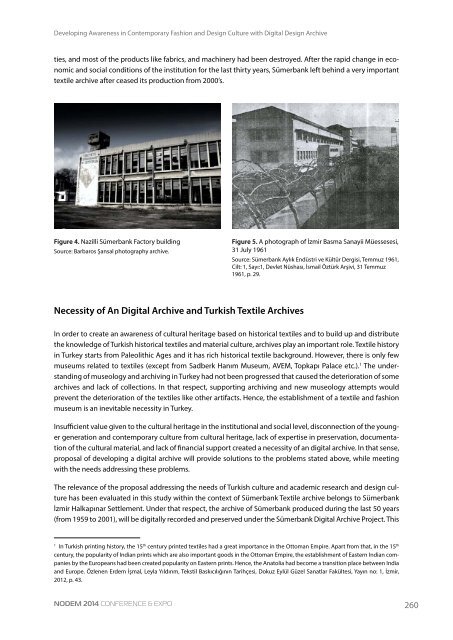NODEM 2014 Proceedings
NODEM 2014 Proceedings
NODEM 2014 Proceedings
You also want an ePaper? Increase the reach of your titles
YUMPU automatically turns print PDFs into web optimized ePapers that Google loves.
Developing Awareness in Contemporary Fashion and Design Culture with Digital Design Archive<br />
ties, and most of the products like fabrics, and machinery had been destroyed. After the rapid change in economic<br />
and social conditions of the institution for the last thirty years, Sümerbank left behind a very important<br />
textile archive after ceased its production from 2000’s.<br />
Figure 4. Nazilli Sümerbank Factory building<br />
Source: Barbaros Şansal photography archive.<br />
Figure 5. A photograph of İzmir Basma Sanayii Müessesesi,<br />
31 July 1961<br />
Source: Sümerbank Aylık Endüstri ve Kültür Dergisi, Temmuz 1961,<br />
Cilt: 1, Sayı:1, Devlet Nüshası, İsmail Öztürk Arşivi, 31 Temmuz<br />
1961, p. 29.<br />
Necessity of An Digital Archive and Turkish Textile Archives<br />
In order to create an awareness of cultural heritage based on historical textiles and to build up and distribute<br />
the knowledge of Turkish historical textiles and material culture, archives play an important role. Textile history<br />
in Turkey starts from Paleolithic Ages and it has rich historical textile background. However, there is only few<br />
museums related to textiles (except from Sadberk Hanım Museum, AVEM, Topkapı Palace etc.). 1 The understanding<br />
of museology and archiving in Turkey had not been progressed that caused the deterioration of some<br />
archives and lack of collections. In that respect, supporting archiving and new museology attempts would<br />
prevent the deterioration of the textiles like other artifacts. Hence, the establishment of a textile and fashion<br />
museum is an inevitable necessity in Turkey.<br />
Insufficient value given to the cultural heritage in the institutional and social level, disconnection of the younger<br />
generation and contemporary culture from cultural heritage, lack of expertise in preservation, documentation<br />
of the cultural material, and lack of financial support created a necessity of an digital archive. In that sense,<br />
proposal of developing a digital archive will provide solutions to the problems stated above, while meeting<br />
with the needs addressing these problems.<br />
The relevance of the proposal addressing the needs of Turkish culture and academic research and design culture<br />
has been evaluated in this study within the context of Sümerbank Textile archive belongs to Sümerbank<br />
İzmir Halkapınar Settlement. Under that respect, the archive of Sümerbank produced during the last 50 years<br />
(from 1959 to 2001), will be digitally recorded and preserved under the Sümerbank Digital Archive Project. This<br />
1<br />
In Turkish printing history, the 15 th century printed textiles had a great importance in the Ottoman Empire. Apart from that, in the 15 th<br />
century, the popularity of Indian prints which are also important goods in the Ottoman Empire, the establishment of Eastern Indian companies<br />
by the Europeans had been created popularity on Eastern prints. Hence, the Anatolia had become a transition place between India<br />
and Europe. Özlenen Erdem İşmal, Leyla Yıldırım, Tekstil Baskıcılığının Tarihçesi, Dokuz Eylül Güzel Sanatlar Fakültesi, Yayın no: 1, İzmir,<br />
2012, p. 43.<br />
<strong>NODEM</strong> <strong>2014</strong> Conference & Expo<br />
260


